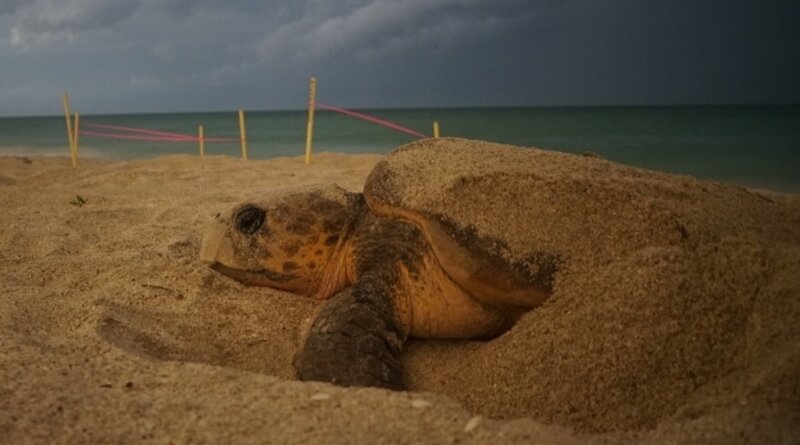Florida heat produces more female sea turtles than males, threatening population : NPR

Sea turtle activities are conducted under Florida Fish and Wildlife Conservation Commission Marine Turtle Permits. Turtle images were acquired while conducting authorized research.
Jake Lasala
hide caption
toggle caption
Jake Lasala

Sea turtle activities are conducted under Florida Fish and Wildlife Conservation Commission Marine Turtle Permits. Turtle images were acquired while conducting authorized research.
Jake Lasala
SARASOTA, Fla. — Each morning during sea turtle nesting season, which occurs between May 1 and Oct. 31, scientists and citizen volunteers comb 35 miles of shoreline in Sarasota County, Fla.
They look for turtle tracks from mothers coming ashore to lay their eggs, or evidence that baby hatchlings have emerged.
Oftentimes, they’ll find tracks leading away from the water because the bright lights of hotels and condominiums on the beach confuse baby turtles, causing them to crawl inland. Experts say about 90% of all sea turtle nesting in the United States takes place on Florida’s beaches.
Coastal development is the biggest threat to sea turtles right now, according to the Florida Fish and Wildlife Conservation Commission. But scientists say global warming is another developing risk to the species. That’s because unlike humans, sea turtles don’t have sex chromosomes. Their gender is determined by the temperature of their nests.
Hot weather produces females, while cool temperatures produce males
“Warmer temperatures will produce more females and cooler temperatures will produce more males. The adage is hot chicks and cool dudes,” says Jake Lasala, with the Mote Marine Sea Turtle Conservation & Research Program in Sarasota.
The process is called temperature-dependent sex determination and it affects a variety of animals, including crocodiles and some lizards.
Sea turtles that incubate in sand that is 81.86 degrees Fahrenheit or lower will be male. Those in sand 88.8 degrees Fahrenheit or higher will be female. Anything in between that range will produce a mix of offspring.
Florida’s summers have been trending warmer for the past two decades, according to Florida State Climatologist David Zierden, and studies show that for several years now, the vast majority of loggerhead sea turtle hatchlings have been female.
That may be good news for male turtles in the short term because they have more female partners.

Marine biologist Alexis Ferrara marks the date when turtle hatchlings emerged from a nest on Lido Beach in Sarasota, Fla.
Cathy Carter
hide caption
toggle caption
Cathy Carter

Marine biologist Alexis Ferrara marks the date when turtle hatchlings emerged from a nest on Lido Beach in Sarasota, Fla.
Cathy Carter
Too many female turtles may lead to population decline because the males can’t keep up
But scientists like Lasala are worried about what climate change could mean for the future of the species. Loggerheads are the most common sea turtle in Florida and are named for their massive, block-like heads. They are also among the larger sea turtles, with adults weighing an average of 275 pounds.
“If there are too many females, then your population can start to decline because the males can’t keep up with the number of females,” Lasala says. “If the temperature continues to increase further than currently projected, then you will start to see the death of hatchlings because eggs can’t develop after a certain temperature.”
And Florida isn’t the only area where heat affects the sex of sea turtles.
A 2018 study found that 99% of the green sea turtle hatchlings on the islands of Australia’s Great Barrier Reef were female.
“So, this isn’t a new thing,” Lasala says. “It’s just we are now seeing it on a larger scale.”
It could be decades before the full impact of this gender imbalance plays out. It takes about 25 years for a sea turtle to reach sexual maturity.
Nonprofit groups work to protect nests of this threatened species from predators
While the marine reptiles are still considered a threatened species, Lasala says their numbers have been rebounding, mainly because state wildlife agencies and nonprofit groups have been working to protect nests from predators and beachgoers.
After digging a hole and depositing about 80-120 eggs, female sea turtles fill in the hole with sand and camouflage the nest before returning to the sea. In Florida, those nests are monitored and marked by tape and wooden stakes.
Even so, only 1 in 1,000 hatchlings actually survives to adulthood, according to the Florida Fish and Wildlife Conservation Commission.
Back on the beach in Sarasota, marine biologist Alexis Ferrara fields several calls from volunteers who report finding stranded hatchlings. The baby turtles are then taken to Mote Marine’s Sea Turtle Rehabilitation Hospital for a health checkup and are then released into the Gulf of Mexico — each a tiny success story.
And even if the Earth keeps getting warmer, Lasala says, all hope may not be lost.
Over time, sea turtles have learned to adapt to their environment.
This past summer, a female loggerhead laid eggs far north of Florida on the cooler sands of the Jersey Shore.






